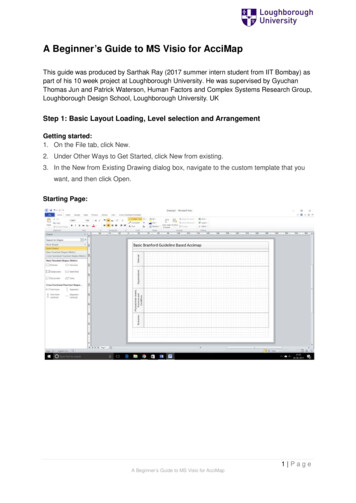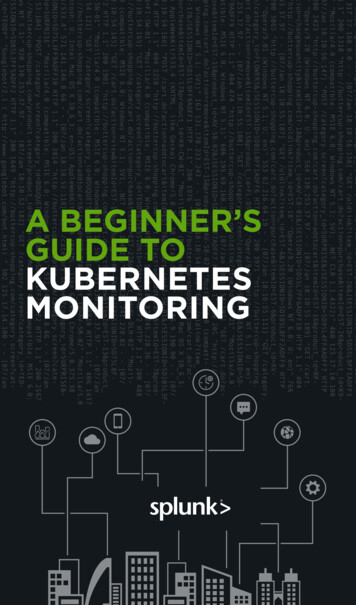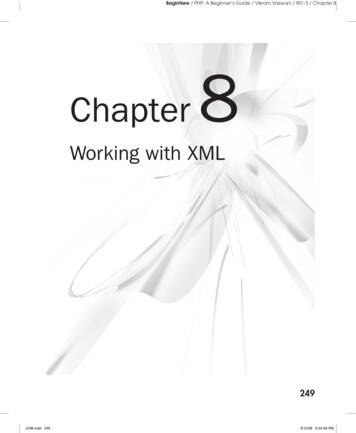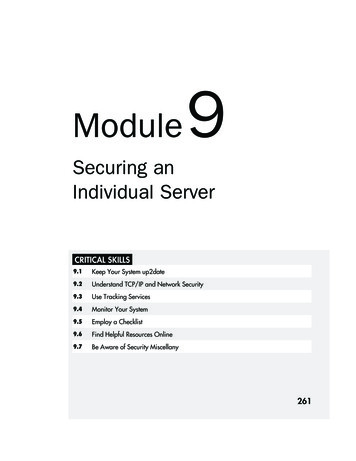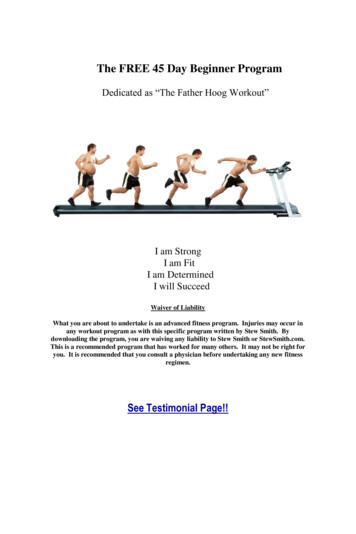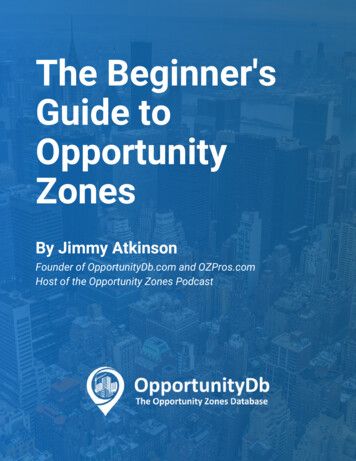
Transcription
The Beginner'sGuide toOpportunityZonesBy Jimmy AtkinsonFounder of OpportunityDb.com and OZPros.comHost of the Opportunity Zones Podcast
1The Beginner’s Guide toOpportunity Zone InvestingBy Jimmy AtkinsonFounder of OpportunityDb and Host of the Opportunity Zones PodcastUpdated October 29, 2020The Opportunity Zone policy initiative is the biggest economic development program inU.S. history — and the tax incentive of a lifetime. This guide provides comprehensiveinformation on how Opportunity Zones have the power to catalyze positive socialimpact, and how you can reap massive tax savings by investing in Qualified OpportunityFunds.Table of ContentsChapter 1: I nequality in America and the promise of place-based policiesHow the rise of inequality in America paved the way for several place-based policiesover the years, leading to the Investing in Opportunity Act, a modified version of whichwas passed as part of the Tax Cuts & Jobs Act of 2017.Chapter 2: T he Investing in Opportunity ActThe Investing in Opportunity Act is the legislation that defines Internal Revenue CodeSection 1400Z, otherwise known as the Opportunity Zones tax incentive. TheCongressional intent of the policy is to redirect private capital into under-invested,economically distressed communities.
2Chapter 3: W hat are Opportunity Zones?The newly created Section 1400Z of the Internal Revenue Code defines “QualifiedOpportunity Zones” as low-income census tracts that were nominated by stategovernors and certified by the U.S. Treasury as Qualified Opportunity Zones.Chapter 4: W hat are Qualified Opportunity Funds?A Qualified Opportunity Fund is any investment vehicle organized as a partnership orcorporation for the purpose of investing in at least one Qualified Opportunity Zone. AQualified Opportunity Fund must hold at least 90 percent of its assets in QualifiedOpportunity Zone Property. Learn how to invest.Appendix: H ow much money can Opportunity Zone investing savetaxpayers?In the appendix to this guide, several examples demonstrate the tax savings potential ofinvesting in Opportunity Zones, and the resulting impact on investment returns.Tax incentives for Qualified Opportunity Zone FundsAn investor who is subject to capital gains as the result of an asset sale can takeadvantage of the tax incentives of investing in a Qualified Opportunity Zone Fund, solong as the investment is made within 180 days of the recognition date.Note 1: For investors who recognize a capital gain through a partnership Schedule K-1,the recognition date for the purposes of Opportunity Zone investing is the due date for thepartnership’s federal tax return, typically March 15 of the following year. For example: apartnership realizes a capital gain on September 1, 2020. The gain is reported on thepartner’s Schedule K-1 by March 15, 2021. The partner would have until September 11,2021 (March 15 180 days) to re-invest his gains into a Qualified Opportunity Fund.Note 2: In June 2020, the IRS issued Notice 2020-39 , which extended the 180-daydeadline to provide taxpayers affected by the coronavirus pandemic with additional relief.
3The notice states that for any 180-day period that ends on or after April 1, 2020 andbefore December 31, 2020, the investment deadline is automatically extended toDecember 31, 2020.The gain can come from any type of asset sale — typically real estate; publicly tradedsecurities such as stocks, bonds, mutual funds, ETFs; the sale of a privately heldbusiness; collectibles; or crypto assets, including Bitcoin.Taxpayers who rollover their capital gains into a Qualified Opportunity Fund can benefitfrom three tax benefits — deferral, reduction, and exclusion.1. Deferral of capital gain recognition from the original investment untilDecember 31, 2026.2. Reduction of capital gain recognition from the original investment. Theamount of capital gain recognized from the original investment is reducedby 10 percent after achieving a 5-year holding period, so long as the 5-yearholding period is achieved by December 31, 2026. There was also a 7-yearhold incentive that reduced capital gain recognition on the original gain by15 percent, but this expired on December 31, 2019.3. Exclusion of capital gain recognition on Qualified Opportunity ZoneProperty held for at least 10 years, so long as the gain from the OpportunityZone investment is recognized by December 31, 2047.How to invest in Qualified Opportunity FundsAnyone with capital gains may invest in Opportunity Zone Funds . In practice, mostQualified Opportunity Funds that are raising money from outside investors have filed foran SEC exemption under Regulation D, Rule 506(b) or 506(c). As such, they have limitedtheir offerings to accredited investors only. With some exceptions, an accreditedinvestor is an individual with annual income of at least 200,000 (or 300,000 of jointincome with spouse) over the last two years, or net worth exceeding 1 million (notincluding primary residence).
4Investment minimums in most Qualified Opportunity Funds that are seeking outsideinvestment are often in the 5- or 6-figure dollar range. Typical investment minimumscan range from 25,000 to 100,000, with some funds requiring a minimum investmentof 250,000, or even 1 million.Hundreds of such funds exist, with varying investment strategies. A list of OpportunityZone funds is available on OpportunityDb.com. In general, Qualified Opportunity Fundsare private placement funds that do not trade publicly on an exchange. While hundredsof funds are available directly to accredited investors, many funds are available onlythrough wirehouse or RIA platforms. And many thousands more are privately held fundsthat are not seeking capital from outside investors.If you have your own real estate deal located in an Opportunity Zone or business that iscapable of having a presence in an Opportunity Zone, you may wish to create your ownself-funded Qualified Opportunity Fund. Visit OZPros.com for information about howyou can get started with forming your own Qualified Opportunity Fund and/or QualifiedOpportunity Zone Business.Disclosure: The author of this guide has ownership in OZPros.com.Chapter 1: Inequality in America and thepromise of place-based policiesBy most appearances, the economic recovery in the United States since the GreatRecession of 2007-09 has been nothing short of phenomenal. By February 2020,unemployment had dropped to 3.5 percent , its lowest rate in decades. And prior to thecoronavirus pandemic, U.S. GDP had been growing at 2 -3 percent per year.But if you look below the surface, it becomes clear that this growth is largely occuringonly in a handful of the wealthiest communities in this country. The recovery from thecoronavirus pandemic may only further exacerbate the unevenness.
5Inequality in the United States is it a problem?So long as we have capitalism, we will have inequality. It’s inherent in the system. Andsome inequality is not necessarily a bad thing. But at what point does inequality domore harm than good? And has the United States already passed an acceptable level ofinequality? By just about any measure, inequality in the U.S. today is at its highest pointin decades.The share of the nation’s wealth held by the top 1% is at its highest level since WorldWar II. Over the past century, inequality in the U.S. peaked during the Roaring Twenties.Wartime economic policies and subsequent post-war expansion resulted in the Great
6Compression: from 1937 to 1947, Roosevelt’s New Deal policies helped raise theincomes of the poor and working class and lowered that of top earners.But beginning in the late 1970s, these trends began to reverse. For roughly the past 40years, economic inequality has been on the rise. The chart above presents the share ofU.S. net personal wealth among the top 1% over the last 100 years.The chart above further illustrates the Great Divergence that began at the end of the1970s. For much of the 1970s, the top 1% of income earners in the U.S. earned roughly11 percent of income, while the bottom 50% earned roughly 20 percent. Today’s figures
7show almost a perfectly mirrored image: the top 1% earns 20 percent, while the bottom50% earns about 13 percent.Does a rising tide lift all boats?There is little debate that economic inequality is growing. (Although its impact has beenchallenged by some .) But it could be argued that growing inequality would not matter solong as the rising economic tide were to lift all boats, so to speak. In other words, solong as people on the lowest rungs of the socioeconomic ladder were increasing theireconomic prosperity over time, growing inequality should be less concerning.But is this the case?An August 2018 study by the Pew Research Center finds that for most U.S. workers,inflation-adjusted wages have not moved in the last 40 years. And most wage gainshave gone to the highest earners. (Although it should be noted that non-wage benefitssuch as employer-sponsored retirement plans and health insurance have increasedmore than wages over this period.)Among the points made in the study: Since 2000, inflation-adjusted usual weekly wages have risen just 3percent among workers in the lowest decile of earnings. Over this same time period, among people in the top decile of earnings,real wages have risen 15.7 percent.So yes, to a certain extent, the rising economic tide has in fact lifted all boats. Evenwage earners at the very bottom of the ladder have more purchasing power today thanthey did 18 years ago, albeit just 3 percent more.Conversely, this study of sluggish and uneven wage growth is one more key factorbehind widening inequality in the United States.
8But why should we be concerned with inequality? At high enough levels, inequality canhave very negative consequences for everyone. It can lead to reduced middle-classincome growth and increased disparities in education, happiness, and health. And as BillGates points out , high levels of inequality can wreak havoc on economic incentives, andultimately skew democracies toward powerful interests.Has inequality in the United States reached a tipping point where it is doing more harmthan good? Left unchecked, capitalism alone may not self-correct toward more equality.But Opportunity Zones may prove to be a tool that provides an incentive for privatecapital to flow into areas of high poverty.The unevenness of the post-recession recoveryTo help us further deal with the unevenness of the economic recovery that has followedthe financial crisis of 2007-08, it is helpful to look at EIG’s Distressed CommunitiesIndex and associated statistics that help define the economic vitality of communitiesaround the country.Based on Census Bureau data from 2011-15, EIG’s DCI combines seven metrics toarrive at an assessment of community economic well-being.1.2.3.4.5.6.7.Adults without a high school diplomaPoverty ratePrime-age adults not in workHousing vacancy rateMedian income ratioChange in employmentChange in establishmentsBased on the averages from these seven metrics, ZIP codes are divided equally intoquintiles with these labels:1. Top 20%: Prosperous2. Next 20% C omfortable
93. Middle 20%: M id-Tier4. Next 20%: A t-Risk5. Bottom 20%: DistressedEconomically distressed communities (the bottom 20% of all ZIP codes in this index)are home to 52.3 million Americans, about 17 percent of the U.S. population. The Southhas a disproportionately high number of distressed communities according to the index.Prosperous ZIP codes dominated the recovery. They contained 29 percent of thenation’s jobs in 2011, but have been home to 52 percent of new jobs created in thefollowing five years. Furthermore, Prosperous ZIP codes captured 57 percent of thenational rise in business establishments from 2011-2015, nearly double their share ofbusinesses in 2011.Meanwhile, Distressed ZIP codes shed more than 17,000 businesses during the period.
10Vacant row houses in BaltimoreOver the five-year period ending in 2015, the U.S. added 10.7 million jobs and 310,000businesses. But that impressive growth was concentrated in Prosperous ZIP codes, 85percent of which saw an increase in businesses during 2011-2015. Conversely, only 22percent of Distressed communities saw an increase in businesses during that timeperiod.The health toll of the disparity is also striking. On average, those living in distressedcommunities will die five years sooner. And death as the result of mental and substanceabuse disorders is 64 percent higher in Distressed counties than in Prosperous ones.How are we to deal with the unevenness of economic growth in the United States? First,we need to answer a hard question: why are a small handful of places capturing all of
11the gains from the economy and getting all of the capital investment, while everywhereelse is getting left behind?The promise of place-based economic developmentPlace-based economic development is based on the concept of economies ofagglomeration , which considers that locations dense in jobs and people are moreefficient and productive.The Tennessee Valley Authority was formed in 1933 as part of Roosevelt’s New Deal. Itmarks one of the federal government’s earliest attempts at place-based policy-making.Its goal was to modernize the economy of the Tennessee Valley region with publicinfrastructure investment in hydroelectric dams, providing power for localmanufacturing.The most prominent form of place-based economic development in the United Statesprior to the enactment of the Opportunity Zone incentive was federal and state urbanenterprise zones, sometimes referred to as empowerment zones. Established in 1994under the Clinton administration, the Empowerment Zone Program createdempowerment zones and enterprise zones. The New Markets Tax Credit (NMTC)Program that was formed as part of the Community Renewal Tax Relief Act of 2000subsequently established renewal communities.Under the NMTC program, local community development entities (CDEs) apply forallocation authority — the authority to raise a certain amount of tax-advantaged capitalfrom investors. The NMTC program grants roughly 3.5 billion per year. The credit is39% of the investment, and is paid out over the course of seven years, which results inabout 1.365 billion in tax credits per year.
12Tennessee Valley Authority power plantThese programs didn’t just offer tax breaks for investors and businesses. They alsopoured government grants into communities to be spent on skills training andwelfare-to-work initiatives.Opportunity Zones are different in that there is no finite amount of government grantmoney to apply for. Nor is it a tax credit program.Rather, the Opportunity Zone initiative creates a powerful tax incentive designed to spurprivate investment in low-income communities. It’s entirely private-sector driven.Investors have far fewer hoops to jump through. And the pool of money being tapped ispotentially enormous compared to the NMTC.EIG estimated that 6.1 trillion in unrealized capital gains are eligible for preferential taxtreatment under the Opportunity Zones initiative, as of year-end 2017. Officials at the
13U.S. Treasury Department have estimated that this could be a 100 billion asset class.Compare that to the 3.5 billion NMTC program, and the difference in scale and thepotential transformative effect become obvious.A common criticism of the program is that it could amount to nothing more than agentrification subsidy, as there are no community benefit requirements. State and cityauthorities will need to come in to counterbalance the temptation for investors to puttheir money in zones already on their way to gentrification. Local governments can usedifferent tools to restrict the growth of undesirable businesses or too much luxuryhousing.ConclusionInequality in the U.S. is worsening. But with the Opportunity Zone legislation passed aspart of the Tax Cuts & Job Act, this imbalance has the potential to change. TheOpportunity Zone initiative as defined in the Act creates an additional incentive forimpact investing, allowing it to tap into a pool of approximately 6.1 trillion.Chapter 2: The Investing in Opportunity Act“It will be the biggest economic development program in U.S. history.”So says Steve Glickman , co-founder and former CEO of the Economic Innovation Group,and one of the chief architects of the Investing in Opportunity Act.Here’s why Glickman is so optimistic: Among U.S. investors and corporations,approximately 6.1 trillion in unrealized capital gains is sitting on the sidelines, as of theend of 2017.Additionally, hundreds of billions of dollars of capital gains are realized every year. In2014 alone, Americans claimed 716 billion in realized capital gains on their tax returns.
14The stock market selloff during February and March of 2020 was likely the biggestcapital gain recognition period ever.These are huge pools of money.And it’s these pools of money that the Investing in Opportunity Act (IIOA) — a modifiedversion of which was passed in December 2017 as part of President Trump’s Tax Cuts& Jobs Act ( H.R.1 ) — was designed to tap into for the benefit of some of the mosteconomically distressed areas of the nation.It does so by defining Qualified Opportunity Zones and by creating an entirely newinvestment vehicle to invest in such zones — the Qualified Opportunity Fund . And byproviding three huge tax incentives for capital gains deployment into these new funds.The capital gains tax benefits are explained in more detail in Chapter 4: What areQualified Opportunity Funds?A brief history of the Investing in Opportunity ActThe Investing in Opportunity Act is bipartisan legislature, co-authored by Senators TimScott (R-SC) and Cory Booker (D-NJ) and Congressmen Pat Tiberi (R-OH) and Ron Kind(D-WI), and championed by nearly 100 congressional co-sponsors. It was initiallyintroduced to both the Senate ( S.293 ) and House ( H.R.828 ) on February 2, 2017.The Economic Innovation Group originally developed the idea in a white paper titledUnlocking Private Capital to Facilitate Economic Growth in Distressed Areas , publishedin April 2015. The paper — authored by Jared Bernstein of the Center on Budget andPolicy Priorities, and Kevin A. Hassett of the American Enterprise Institute — makes nomention of “Opportunity Zones” or “Qualified Opportunity Funds,” but lays thegroundwork for the preferential treatment of capital gains deployed to distressed areasof the country.
15Senators Tim Scott (R-SC) and Cory Booker (D-NJ) were co-sponsors of the Investing in OpportunityAct.The Investing in Opportunity Act encourages investment in economically distressedcommunities by offering three huge tax incentives, which are detailed in Chapter 4 ofthis guide.What is a low-income community?The intent of the Investing in Opportunity Act is to funnel investment into low-incomecommunities that have been long overlooked. But, what is a low-income communityexactly?
16The legislation defines “Qualified Opportunity Zones” as low-income census tracts thatwere nominated by each state’s governor and subsequently certified by the U.S.Treasury as Qualified Opportunity Zones.For purposes of defining an Opportunity Zone, the term “low-income community” takesits definition from Section 45D(e) of the IRS Code , which states that a populationcensus tract, in general, is low-income if:(A) the poverty rate for such tract is at least 20 percent, or(B) (i) in the case of a tract not located within a metropolitan area, themedian family income for such tract does not exceed 80 percent ofstatewide median family income, or (ii) in the case of a tract locatedwithin a metropolitan area, the median family income for such tractdoes not exceed 80 percent of the greater of statewide median familyincome or the metropolitan area median family income.There are a few caveats to this definition that deal with targeted populations, areas notlocated within census tracts, low-population tracts, and high-migration ruralcommunities, which are explained in more detail in the code.Some contiguous non-low-income community census tracts that lie adjacent tolow-income census tracts are also designated as Opportunity Zones.What is a contiguous non-LIC census tract?Certain non-low-income community (non-LIC) census tracts were able to be designatedas Opportunity Zones if they were:
17(A) contiguous with the low-income community that is designated asa qualified opportunity zone, and(B) the median family income of the tract does not exceed 125 percentof the median family income of the low-income community with whichthe tracts is contiguous.But no more than 5 percent of a state’s Opportunity Zones can be contiguous non-LICtracts.Qualified Opportunity Zone designationsThe legislation called for the governors from all 50 states and U.S. territories, plus themayor of Washington DC, to nominate Opportunity Zones from their jurisdictions. Thegovernors could nominate up to 25 percent of their low-income census tracts.An exception was made for states with fewer than 100 eligible tracts; these states wereallowed up to 25 tracts to be designated as Opportunity Zones. Alaska, Delaware, theDistrict of Columbia, Guam, Hawaii, Montana, North Dakota, Rhode Island, South Dakota,Vermont, and Wyoming were able to take advantage of this exception: they each haveexactly 25 Opportunity Zones.American Samoa, Northern Mariana Islands, and Virgin Islands each have fewer than 25eligible census tracts. As a result, 100 percent of their eligible tracts were designated asOpportunity Zones.Additionally, the 2018 Bipartisan Budget Act allowed for every low-income census tractand eligible non-LIC census tract in Puerto Rico to be certified as a QualifiedOpportunity Zone. As a result, nearly the entire island of Puerto Rico lies within anOpportunity Zone.
18The zone designations were finalized by the IRS in June 2018 and remain effectivethrough the end of 2028.More detail on Opportunity Zones can be found in Chapter 3.Puerto Rico suffered massive damage from Hurricane Maria in 2017.The creation of the Qualified Opportunity FundTo receive the preferential tax treatment that Opportunity Zone investing offers,investments must flow through a newly created investment vehicle — the QualifiedOpportunity Fund.
19Opportunity Zone funds can be structured as corporations or partnerships. They mustinvest substantially in 1) Qualified Opportunity Zone Businesses (QOZBs) that holdQualified Opportunity Zone Business Property (QOZBP), 2) Qualified Opportunity ZoneProperty (QOZP) directly, or 3) a combination of the two. In general, a QualifiedOpportunity Fund must hold at least 90 percent of its assets in QOZBs or other QOZP.Certain “sin” businesses (golf courses, country clubs, massage parlors, hot tub facilities,suntan facilities, racetracks or other facilities used for gambling, and liquor stores) areineligible for investment.More detail on Qualified Opportunity Funds can be found in Chapter 4.Chapter 3: What are Opportunity Zones?An Opportunity Zone is a low-income census tract that has been nominated by its stategovernor and certified by the Treasury Department. The nation’s Opportunity Zonesstand poised to receive a huge influx of investment, given the enormous tax incentivesthat the new legislation has created.The Investing in Opportunity Act makes a big promise to these zones. But will thepromises of economic growth (without too much resident displacement) come tofruition?Opportunity Zone facts and figuresOn June 14, 2018, the U.S. Treasury and IRS finalized certification of the OpportunityZones . In total, 8,762 census tracts were certified as Qualified Opportunity Zones. Thesezones are located in all 50 states, the District of Columbia, and all five inhabitedoverseas territories. In December 2018, new data from the Census Bureau allowed for
20Puerto Rico to be granted two additional Opportunity Zones , bringing the final total to8,764.A total of 8,534 out of 31,866 census tracts defined as low-income were designated asOpportunity Zones. An additional 230 eligible contiguous tracts (not defined aslow-income) were designated as well.Nearly 35 million Americans live in these zones, per 2015 American Community Surveydata. The average poverty rate in the Opportunity Zones is 32 percent, compared to 17percent for the average census tract.A total of 8,764 census tracts are certified as Qualified Opportunity Zones.An interactive Opportunity Zone map is available at OpportunityDb.com/map
21Here’s the breakdown by 5250American o28262Illinois3273270
Nevada61601New Hampshire27270New Jersey1691690New Mexico63594
23New York51449717North Carolina25224111North Dakota25250Northern Mariana ennsylvania30028911Puerto Rico86383726Rhode Island25250South Carolina1351287South rmont25232Virgin Islands14131Virginia2122075
24Washington1391327Washington DC25250West ty Zone idealsBy design, the Opportunity Zones program targets under-invested low-incomecommunities on the margins — places where private investment would be highlycatalytic. The very worst-off places in the nation are just not capable of attractiveprivate investment. Conversely, communities already on an upswing would be a wasteof program dollars.As Annie Lowery puts it in The Atlantic , “Opportunity zones are meant to beGoldilocks-type places: not so distressed that no amount of government incentivewould induce private money to them, not distressed but gentrifying and thus alreadyseeing a flood of private money coming in.”How to invest in Opportunity ZonesTaxpayers wishing to invest in Opportunity Zones are required to deploy capital gains inQualified Opportunity Funds . Such funds are structured as corporations or partnershipsand invest in Qualified Opportunity Zone Property.
25What is Qualified Opportunity Zone Property (QOZP)?Qualified Opportunity Zone Property (QOZP) can be one of two things — 1) a QualifiedOpportunity Zone Business (QOZB); or 2) Qualified Opportunity Zone Business Property(QOZBP). A QOZB can be structured as either a corporation or a partnership and musthold at least 90 percent of its assets in QOZP.QOZBP is tangible property used in trade or business of a Qualified Opportunity Fund.Qualified Opportunity Zone Property is explained in more detail in Chapter 4: What areQualified Opportunity Funds?Opportunity Zones vs. NMTCPrior to Opportunity Zones, the most recent place-based economic policy was the NewMarkets Tax Credit (NMTC) program. Much of the Opportunity Zones regulatorylanguage is borrowed from the NMTC program, but there are a few substantialdifferences.Program MechanicsEach program was developed to incentivize capital investment in under-invested areasof the country. But there are key differences in the mechanics of how this goal isachieved.Under the NMTC program, a taxpayer invests cash in a special financial intermediarytermed a Community Development Entity (CDE), which then invests in businesses withina zone. Each CDE must be pre-approved by the Treasury Department and is required toprovide governance rights to community representatives.Under the Opportunity Zones program, there is much less oversight. A taxpayer investscapital gains into Qualified Opportunity Funds, which then invests in businesses within a
26zone. But unlike CDEs, which must be pre-approved by Treasury, Opportunity Zonefunds simply self-certify. There is zero pre-approval process, no community benefitrequirement, and no requirement to provide governance rights to communityrepresentatives.Tax BenefitThe tax benefit differs substantially as well. In the NMTC program, a dollar-for-dollarannual tax credit equal to the amount invested in a Community Development Entity(CDE) is granted to the taxpayer. But the taxpayer would still owe tax on any gainsrealized by the CDE.The U.S. Treasury department oversees both the NMTC and OZ programs.
27But under the Opportunity Zones incentive, investors can deploy capital gains from anyasset into a Qualified Opportunity Fund. There are three tax benefits of this program: 1)deferral of capital gains tax until December 31, 2026; 2) reduction of capital gains taxdue; 3) elimination of tax due on capital gains from Opportunity Zone investments.Financial ImpactThe NMTC allocates 3.5 billion in qualified equity investments annually. Conversely,the Opportunity Zones initiative has no limit to the amount of investment that can bemade. Because of this, some believe that Opportunity Zones will dwarf the NMTC interms of financial impact.EIG’s former CEO Steve Glickman has called the Opportunity Zones initiative “thebiggest economic development program in U.S. history.” And Treasury Secretary StevenMnuchin believes there will be “over 100 billion of private capital” invested inOpportunity Zones.Chapter 4: What are Qualified OpportunityFunds?Qualified Opportunity Funds (QOFs) were created under the Investing in Opportunity Act ,a version of which was passed as part of President Trump’s Tax Cuts & Jobs Act of2017. Per the IRS, QOFs self-certify using IRS Form 8996 , with no approval processrequired . These new funds provide massive tax incentives for investing capital gains insome of America’s most economically distressed communities.
28Qualified Opportunity Funds definedThe U
Oct 29, 2020 · 3 The notice states that for any 180-day period that ends on or after April 1, 2020 and before December 31, 2

